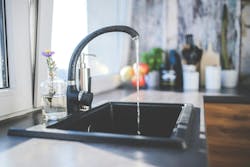Faucet Foundations
About the author: Christopher Salazar is former general manager of the plumbing division for NSF Intl. For more information, contact NSF at [email protected] or 800.673.6275.
Faucets are the most used and abused fittings in a plumbing system. We use faucets to draw water for drinking and washing multiple times a day, every day. They are exposed to different types of water passing through them, at different pressures and temperatures. They also must be able to withstand a variety of cleaning agents of different compositions in both hard and soft water.
To make sure faucets can withstand all of these stresses over time, and to ensure that they do not leach harmful levels of contaminants into drinking water, a number of standards regulate faucets and faucet accessories. All model plumbing codes in North America require faucets to be certified by an accredited third-party listing agency, such as NSF Intl. These codes spell out that faucets need to comply with ASME A112.18.1/CSA B125.1, which is a harmonized standard between the U.S. and Canada. These codes and ASME A112.18.1/CSA B125.1 also require faucets to comply with NSF/ANSI Standards 61 and 372.
The reason that so many standards are required is that each addresses a different scope:
- ASME A112.18.1/CSA B125.1 is a performance standard that covers design and general use.
- NSF/ANSI 61 is a health effects standard that covers materials that come into contact with drinking water.
- NSF/ANSI 372 is a standard that covers the weighted average of lead content of materials that are in contact with drinking water.
ASME A112.18.1/CSA B125.1
ASME A112.18.1/CSA B125.1 covers the design requirements of plumbing supply fittings. Faucets are required to function at pressures of 20 to 125 psi at a rated temperature of 40°F to 160°F. One of the design requirements specifies that the faucet must be able to be serviced—to replace worn parts, for example—without having to remove the installed faucet. The standard also requires that the design of the faucet includes proper backflow prevention (an air gap), threaded connections complying with ASME B1.20, and faucet compliance with NSF/ANSI 61 for toxicity and NSF/ANSI 372 for lead content.
The ASME/CSA standard also contains performance requirements and test procedures. Faucets are subject to various testing requirements such as corrosion (all substrates and coatings), thermal cycle, water degradation, soap and cleaner effects, abrasion resistance, aerators and other end point devices, flow rate, cycling, test loads, bending strength and backflow prevention.
Companies that produce water-efficient bathroom faucets and faucet accessories, like aerators, also can seek compliance with the U.S. Environmental Protection Agency’s WasterSense program, which demonstrates both water efficiency and the ability to provide ample flow. WaterSense-certified faucets and faucet accessories must conform to applicable requirements in ASME A112.18.1/CSA B125.1 and NSF/ANSI 61, Section 9. The flow rate must be tested in accordance with the procedures in ASME A112.18.1/CSA B125.1 and cannot exceed 1.5 gal per minute (gpm) at a pressure of 60 psi at the inlet when water is flowing. The minimum flow rate cannot be less than 0.8 gpm at
a pressure of 20 psi at the inlet when water is flowing.
NSF/ANSI Standard 61
NSF/ANSI 61: Drinking Water System Components – Health Effects limits the amounts of impurities individual products can introduce into a home’s water supply. This includes limiting inorganic contaminants like lead and other metals, as well as organic contaminants like volatile organic compounds, phthalates and bisphenol A. All kitchen and bathroom faucets sold in North America are required to comply with NSF/ANSI 61 by most governmental agencies that regulate drinking water supplies. Developed by a team of scientists, industry experts and key industry stakeholders, this standard focuses on the evaluation of contaminants and impurities imparted indirectly into drinking water.
Section 9 of the standard pertains to faucets, which are tested through a 19-day exposure protocol performed under controlled laboratory conditions. Water samples are collected and analyzed for compliance with the standard. Metal contaminant testing includes antimony, arsenic, barium, berylium, cadmium, chromium, copper, lead, mercury, selenium, thallium, nickel, zinc and bismuth. Nonmetal testing is formulation dependent, but includes looking for a variety of potential contaminants that might be released from any of the plastic, elastomeric or coated components in contact with drinking water. The standard also requires that products (including solders and flux) do not contain lead in excess of federal requirements for lead-free plumbing under the U.S. Safe Drinking Water Act (SDWA).
NSF/ANSI Standard 372
NSF/ANSI 372: Drinking Water System Components – Lead Content covers test procedures to verify that products like faucets do not contain a weighted average lead content in excess of 0.25%. This new, lower-lead content requirement came into effect nationally in response to a revised definition of lead-free plumbing placed into effect in the SDWA in January 2014.
NSF/ANSI 372 provides a standardized methodology for determining weighted average lead content and covers all products intended to convey or dispense water for human consumption through drinking or cooking. The standard also sets criteria for lead content verification of the materials used. At NSF, screening for lead content is performed by X-ray fluorescence (a quick screening test for lead content) and utilizes a material dissolution procedure followed by lead content analysis via inductive coupled plasma mass spectrometry as needed.
Download: Here
